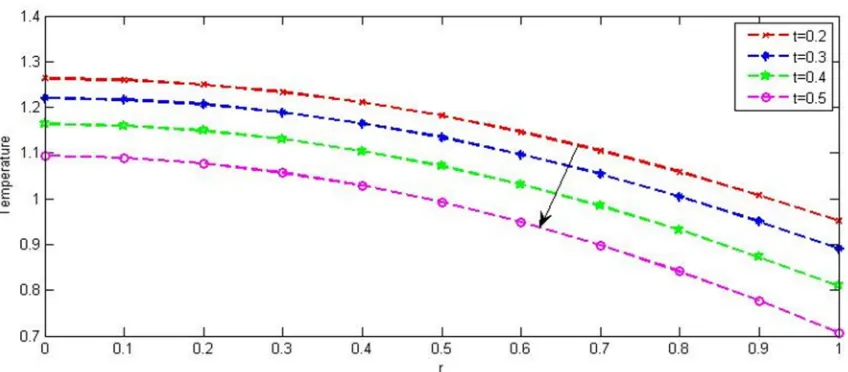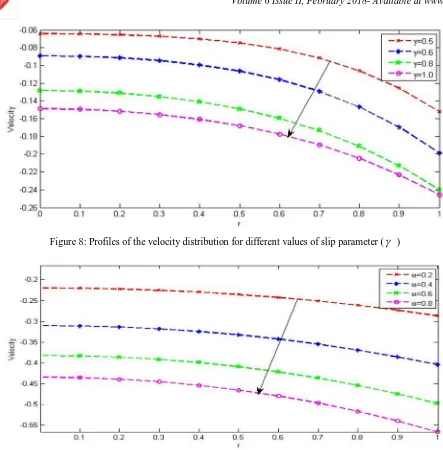Unsteady MHD Oscillatory Flow in a Circular Pipe
through a Porous Medium with Heat Transfer:
Effects of Externally Applied Magnetic Field
M. Chitra1, V.Kavitha2
1
Associate Professor, 2Research Scholar, Department of Mathematics, Thiruvalluvar University, Vellore-632 115, Tamilnadu, India
Abstract: In this paper, Influence of an externally applied homogeneous magnetic field, radiative heat transfer on unsteady viscous incompressible oscillatory fluid flow through a porous medium in a circular pipe with time varying pressure gradient are investigated. Main idea of our work is to study these phenomena mathematically and the equation of momentum and energy are solved analytically for the velocity and temperature. The effects of Hartmann number, porosity parameter, radiative parameter and frequency of the oscillation of the wall slip on temperature and velocity profiles are discussed and results are shown graphically.
Keywords: Heat transfer, MHD, Oscillatory flow, porous medium, Time varying pressure gradient.
I. INTRODUCTION
The flow of conducting fluid and heat transfer has important applications in many branches of engineering science such as petroleum transport, wastewater treatment, oil recovery technique, power plant piping, engineering and heat storage, etc. particularly, the flow and heat transfer in a circular pipes with an externally magnetic field occurs in magne to hydro dynamics (MHD) generators pumps, accelerators, nuclear reactors, geothermal systems and others. El-Hakiem (2000) analysed thermal radiation effects on transient, two-dimensional hydromagnetic free convection along a vertical surface in a highly porous medium using the Roseland diffusion approximation for the radiative heat flux in the energy equation, for the case where free- stream velocity of the fluid vibrates about mean constant value and the surface absorbs the fluid with constant velocity. Unsteady laminar hudromagnetic fluid – particle flow and heat transfer in channels and circular pipes has been investigated by Chmkha.J. (2000). Makinde and Mhone (2005) by considering the fluid slip at the lower wall. Makinde and Mhone (2005) have considered heat transfer to MHD oscillatory flow in a channel filled with porous medium. The effect of slip condition on MHD steady flow in a channel with permeable boundaries has been discussed by Makinde and Osalusi (2006). Cheng (2006) presented the free convection heat and mass transfer from a horizontal cylinder of elliptic cross section in a micropolar fluid. Thereafter, Panda et al. (2006) analyzed the free convection of conducting viscous fluid between two vertical walls filled with porous material. Mehmood and Ali (2007) discussed the effect of slip condition on unsteady MHD oscillatory flow of a viscous fluid in a planer channel. Mustafa et al (2008) investigated unsteady MHD memory flow with oscillatory suction, variable free stream and heat sour. Recently the combine effect of magnetic field and permeable wall slip velocity on the steady flow of an electrical conducting fluid in a circular vertical piped- uniform width has been analysed by Elangovan and Ratchagar (2010). Unsteady heat transfer to MHD oscillatory flow through a porous medium under slip condition has been investigated by Hamza and Isha (2011). Khem Chand (2013) studied Hydromagnetic periodic flow in a circular pipe through porous medium with heat transfer in slip flow regime. The purpose of this paper is to obtain the influence of an externally applied magnetic field, radiative heat transfer on unsteady viscous incompressible fluid flow in a circular pipe through porous medium. The effects of porosity parameter(S), radiative parameter (N), Hartmann number (H), slip parameter ( ), Reynolds number (Re), Peclet number (Pe), frequency ( ) and time (t) on the velocity and temperature profiles are discussed graphically.
II. MATHEMATICAL FORMULATION
Consider the unsteady, laminar, hydromagnetic oscillatory fluid flow in a circular pipe through a porous medium under the influence of an externally applied homogeneous magnetic field and radiative heat transfer. It is assumed that the fluid has a small electrical conductivity and the electromagnetic force produced is very small. Let
x
'
-axis be the axis along the axis of the pipe and2
2 '
' ' 2 ' '
' 0
' ' ' ' ' '
1
1
eB u
u
p
u
u
u
t
z
r
r
r
k
(1)The equation of energy is
2
' 2 ' ' '
' ' ' ' '
1
p
T
T
T
q
C
k
t
r
r
r
r
(2)
With boundary conditions: ' ' * '
0
u
u
r
,
' ' ' ' ' '0 0
cos
T
T
T
T
t
atr
'
1
' '
0
u
r
' '0
T
r
at'
0
r
(3)Where
u
' is the axial velocity,t
' is the time,
' is the frequency of the oscillation,T
' The fluid temperature,p
is the pressure,k
is the thermal conductivity,C
p the specific heat at constant pressure,q
the radiative heat flux,K
' the porous mediumpermeability coefficient,
B
0 the electromagnetic induction,
e the conductivity of the fluid,
the density of the fluid,
is the kinematic viscosity coefficient. It is assumed that walls temperatureT
0' ,T
' are high enough to induce radiative heat transfer, and*
is the dimensionless slip parameter. Assumed that the radiative heat flux and varying pressure gradient are given by
'
2 ' ' 0 '
4
q
T
T
r
(4)i t
P
e
z
(5)Where
is the mean radiation absorption coefficient and introducing the dimensionless variables and parameters are:Re
Ua
, 'r
r
a
, 'z
z
a
, 'u
u
U
, 2 2 2 eB a
0H
, ' ' 0 ' ' 0T
T
T
T
, 't U
t
a
, 'aP
P
U
, ' 2 aK
D
a
,Pe
Ua C
pk
, *a
, 2 2 24
a
N
k
(6)Where U is the flow mean velocity. In terms of these variables, equation (1) and (2) [non dimensional] becomes
2
2 2 2
1
Re
u
e
i tu
u
S
H
u
t
r
r r
(7)2
2 2
1
Pe
N
t
r
r
r
(8)With boundary conditions are:
1.
u
u
0
r
,
cos
t
atr
1
(slip condition)2. ,
0
r
Where H is the Hartmann number, N is the radiation parameter,
Pe
is the Peclet number,Re
is the Reynolds number,D
a is theDarcy number,
is the slip parameter andS
(1/
D
a)
is the porous shape factor.III. METHOD OF SOLUTION
In order to solve the equation (7) to (9) for purely oscillatory flow, we assume the solution of the form
,
i tu r t
f r e
,
r t
,
0
r e
i t (10)Where
is the frequency of the oscillation and substituting the above expressions in to (7) and (8) using (9),
" 1 '
2 2
Re f r e( ) i ti ei t f ( )r ei t f ( )r ei t S H f r e( ) i t r
(11)
(12) We get,
2" 1 '
( ) ( ) ( )
f r f r C f r
r
(13)
2" '
0 0
1
( )r ( )r D ( )r 0 r
(14)
Where
C
S
2
H
2
i
Re
,D
i Pe N
2 Equations (13) and (14) are Bessel equations of order zero.We have
(15)
0
( , )
r t
BJ
r
D
e
i t
(16)On simplifying we get,
(17)
0 0
, J r D i t
r t e
J D (18)
IV. GRAPHICAL RESULTS AND DISCUSSIONS
The effects of wall slip, porosity of medium, magnetic field, radiation parameter, thermal force, Harmann number, Renolds number, Peclet number, and oscillations on flow- field on studied analytically by using Bessel function. The numerical values are discussed from analytical solution. We made use of the following parameter values except otherwise indicated, S=1, H=1,Pe=1, Re=1, N=1,
[image:4.612.63.507.572.718.2]=1, = /2,
=1. The velocity and temperature profiles have been computed in graphs 1 to 9.Figure 2: Profiles of the temperature for different values of the frequency of the oscillation (
)Figure 3: Profiles of the temperature for different values of the Peclet number (
Pe
) [image:5.612.92.516.528.714.2]Figure 5: Profiles of the velocity distribution for different values of the Hartmann number (
H
)Figure 6: Profiles of the velocity distribution for different values of the Reynolds number (
Re
) [image:6.612.85.523.300.708.2]Figure 8: Profiles of the velocity distribution for different values of slip parameter (
)Figure 9: Profiles for velocity distribution for different values of the frequency of the oscillation (
)A. The figures 1,2 and 3 indicates the temperature profiles increases as the increases of the radiation parameter, frequency of the oscillation and Peclet number.
B. The figure 4 illustrates the temperature profiles decreases as the increases of the time.
C. The figures 5, 6 and 7 exhibit the velocity profiles increases as the increases of the Hartmann number, Reynolds number and porosity parameter..
D. The figures 8 and 9 present the velocity profiles decreases as increases of the slip parameter and frequency of oscillation
V. CONCLUSIONS
REFERENCES
[1] El-Hakiem, M.A (2000): MHD Oscillatory Flow on Free Convection-radiation through a Porous medium with constant suction velocity. Journal of Magnetism and Magnet Materials.220 (2-3), Pp. 271 – 276.
[2] A.J. Chamkha (2000): Unsteady laminar hydromagnetic fluid-particle flow and heat transfer in channels and circular pipes, Int. Journal of Heat and fluid flow 21(2000) 740– 746.
[3] O. D. Makinde and P. Y. Mhone, “Heat transfer to MHD oscillatory flow in a channel filled with porous medium,” Romanian Journal of Physics, vol. 50, pp. 931–938, (2005).
[4] O. D. Makinde, P. Y. Mhone, Heat transfer to MHD oscillatory flow in a channel filled with porous medium, Rom. J. Phys. 50(9–10) (2005) 931–938 [5] O. D. Makinde, E. Osalusi, MHD Steady flow in a channel with slip at the permeable boundaries, Rom. J. Phys. 51(3–4) (2006) 319–328.
[6] Cheng C.Y, Free convection heat and mass transfer from a horizontal cylinder of elliptic cross section in micropolar fluid, Int. Comm.Heat Mass Transfer. Vol.33,pp.311‐318,( 2006)
[7] Panda J.P, Pattnaik A.B. and Acharya A, Free convection of conducting viscous fluid between two vertical walls filled with porous material. AMSE. Mod. Meas. Cont. B. Vol.75 (3), pp.31‐44, (2006).
[8] Mehmood, A and A. Ali (2007): The Effect of Slip Condition on Unsteady MHD Oscillatory Flow of a Viscous Fluid in a Planner Channel. Rom. Journal of Physics, 52(1-2), Pp. 85 – 91
[9] Mustafa S, Rafi’uddin and M.V. Ramana Murthy (2008): Unsteady MHD Memory Flow with Oscillatory suction, Variable free stream and heat source. ARPN Journal of Engineering and Applied Sciences, 3(3), Pp. 17 – 24.
[10] Elangovan K. and Ratchagar, N. P., (2010). Steady flow through a circular vertical pipe with slip at the permeable boundary with an applied magnetic field, Applied Mathematical Sciences, 4(50), pp. 2445-2452.
[11] M.M. Hamza, B.Y. Isha ., (2011) Unsteady heat transfer to MHD oscillatory flow through a porous medium under slip condition, Int.journal of computer Applications(0975 – 8887),vol.33 – No.4
[12] Khem Chand, K.D. Singh and Sanjeev kumar, “ Hydromagnetic periodic flow in a circular pipe through porous medium with heat transfer in slip flow regime”, Research J. Science and Tech 5(1): Jan-Mar 2013 page 148-152.



